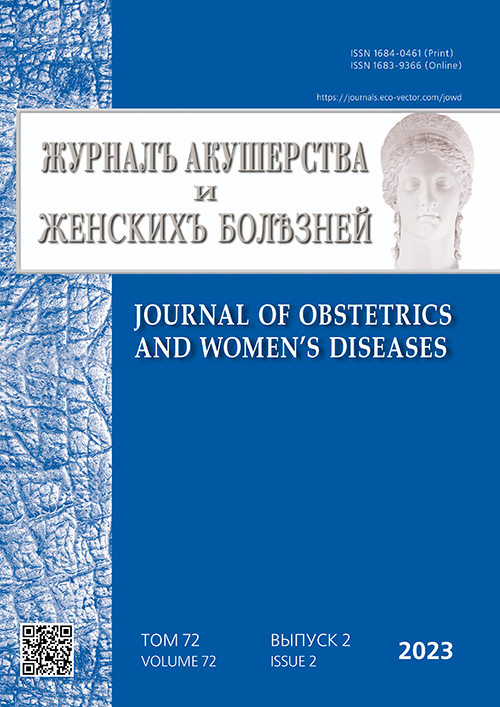Use of combined hormonal contraceptives in women with uterine fibroids: opinions of practitioners
- Authors: Aganezova N.V.1, Aganezov S.S.1, Shilo M.M.1
-
Affiliations:
- North-Western State Medical University named after I.I. Mechnikov
- Issue: Vol 72, No 2 (2023)
- Pages: 105-112
- Section: Clinical practice guidelines
- Submitted: 10.03.2023
- Accepted: 03.04.2023
- Published: 18.05.2023
- URL: https://journals.eco-vector.com/jowd/article/view/321247
- DOI: https://doi.org/10.17816/JOWD321247
- ID: 321247
Cite item
Abstract
BACKGROUND: Uterine fibroids are increasingly diagnosed in patients of reproductive age. Combined hormonal contraceptives provide reliable protection against unwanted pregnancy and help to reduce or eliminate various clinical manifestations of uterine fibroids. In practice, obstetrician-gynecologists have “barriers” to prescribing combined hormonal contraceptives to patients with uterine fibroids.
AIM: The aim of this work was to study the features of the clinical approach of obstetrician-gynecologists to the management of patients with uterine fibroids interested in combined hormonal contraception.
MATERIALS AND METHODS: The method of voluntary anonymous questioning was applied to 366 obstetrician-gynecologists. The work experience of 62.1% (n = 227) of doctors was 10 years or more. The questionnaire included questions about various aspects of the use of combined hormonal contraceptives for contraception in women with uterine fibroids.
RESULTS: Only every second (47.5%; n = 174) obstetrician-gynecologist correctly assigns uterine fibroids to the first category of acceptability for combined hormonal contraceptives. The presence of an asymptomatic submucous myomatous node (FIGO 1–2) or dysmenorrhea in women with uterine fibroids is considered by 29.0% (n = 106) and 5.7% (n = 21) of obstetrician-gynecologists, respectively, as a contraindication to the use of combined hormonal contraceptives. Every ninth participant (11.4%; n = 42) believes that the presence of uterine fibroids limits the duration of use of combined hormonal contraceptives for contraception to 1–5 years. Almost half (45.6%; n = 167) of the respondents believe that combined hormonal contraceptives have various effects on uterine fibroids (cause regression or growth of fibroids, increase the risk of new fibroids). More than half (53.3%; n = 195) of the respondents are not informed about the reduction in the risk of developing uterine fibroids when using combined hormonal contraceptives for five years or more.
CONCLUSIONS: In the analyzed cohort of experienced obstetrician-gynecologists, we identified their “barriers” to prescribing combined hormonal contraceptives for contraception for women with uterine fibroids. Those are incomplete awareness of the acceptance criteria for combined hormonal contraceptives and insufficient awareness of the lack of effect of combined hormonal contraceptives on the size of existing myomatous nodes and a decrease in the risk of developing uterine fibroids when using combined hormonal contraceptives for five or more years.
Full Text
About the authors
Natalia V. Aganezova
North-Western State Medical University named after I.I. Mechnikov
Author for correspondence.
Email: aganezova@mail.ru
ORCID iD: 0000-0002-9676-1570
Scopus Author ID: 57191916251
MD, Dr. Sci. (Med.), Professor
Russian Federation, Saint PetersburgSergey S. Aganezov
North-Western State Medical University named after I.I. Mechnikov
Email: aganezov@mail.ru
ORCID iD: 0000-0002-3523-9922
SPIN-code: 8186-6778
Scopus Author ID: 55744676600
MD, Cand. Sci. (Med.), Assistant Professor
Russian Federation, Saint PetersburgMaria M. Shilo
North-Western State Medical University named after I.I. Mechnikov
Email: mariya.shilo.95@mail.ru
ORCID iD: 0000-0002-7558-8342
SPIN-code: 8358-5911
MD, PhD student
Russian Federation, Saint PetersburgReferences
- Giuliani E, As-Sanie S, Marsh EE. Epidemiology and management of uterine fibroids. Int J Gynaecol Obstet. 2020;149(1):3–9. doi: 10.1002/ijgo.13102
- Ermolenko KS, Radzinsky VE, Rapoport SI. State-of-the-art of realization of the fertility potential in the women of late reproductive age. Clinical Medicinel. 2016;94(1):10–15. (In Russ.) doi: 10.18821/0023-2149-2016-94-1-10-15
- Federal’naya sluzhba gosudarstvennoy statistiki. Zdravookhranenie v Rossii. 2021. (In Russ.) [cited 2023 Jan 21]. Available from: https://rosstat.gov.ru/storage/mediabank/Zdravoohran-2021.pdf/
- Zimmermann A, Bernuit D, Gerlinger C, et al. Prevalence, symptoms and management of uterine fibroids: an international internet-based survey of 21,746 women. BMC Womens Health. 2012;12:6. doi: 10.1186/1472-6874-12-6
- Vikhlyaeva EM, Zheleznoe B, Zaporozhan VN, et al. Rukovodstvo po endokrinnoi ginekologii. Moskva: Meditsinskoe informatsionnoe agenstvo; 1997. (In Russ.)
- Ministerstvo zdravookhraneniya Rossiyskoy federatsii. Mioma matki. Klinicheskie rekomendatsii. 2020. (In Russ.) [cited 2023 Jan 21]. Available from: https://roag-portal.ru/recommendations_gynecology
- VOZ: Evropeyskoe regionarnoe byuro. Meditsinskie kriterii priemlemosti dlya ispol’zovaniya metodov kontratseptsii. 2015. (In Russ.) [cited 2023 Jan 21]. Available from: https://www.who.int/ru/activities/preventing-noncommunicable-diseases/9789241549158
- Dragoman MV, Tepper NK, Fu R, et al. A systematic review and meta-analysis of venous thrombosis risk among users of combined oral contraception. Int J Gynaecol Obstet. 2018;141(3):287–294. doi: 10.1002/ijgo.12455
- Loginova ON, Sonova MM, Arslanyan KN. Progesterone and uterine fibroids. a review of the literature. Health and Education Millennium. 2018;20(1):92–98. (In Russ.) doi: 10.26787/nydha-2226-7425-2018-20-1-92-98
- Ross RK, Pike MC, Vessey MP, et al. Risk factors for uterine fibroids: reduced risk associated with oral contraceptives. Br Med J (Clin Res Ed). 1986;293(6543):359–362. doi: 10.1136/bmj.293.6543.359
- Chiaffarino F, Parazzini F, Vecchia La C, et al. Use of oral contraceptives and uterine fibroids: results from a case-control study. Br J Obstet Gynaecol. 1999;106(8):857–860. doi: 10.1111/j.1471-0528.1999.tb08409.x
- Tikhomirov AL, Kazenashev VV. Rationale for a prolonged low-dose combined oral contraceptive pill regimen in the combination treatment of patients with uterine myoma and typical endometrial hyperplasias. Obstetrics and Gynecology. 2013;(8):113–116. (In Russ.)
- Qin J, Yang T, Kong F, Zhou Q. Oral contraceptive use and uterine leiomyoma risk: a meta-analysis based on cohort and case-control studies. Arch Gynecol Obstet. 2013;288(1):139–148. doi: 10.1007/s00404-013-2797-9
- Yang Q, Ciebiera M, Bariani MV, et al. Comprehensive review of uterine fibroids: developmental origin, pathogenesis, and treatment. Endocr Rev. 2022;43(4):678–719. doi: 10.1210/endrev/bnab039
- Tikhomirov AL. Mioma. Patogeneticheskoe obosnovanie organosokhranyayushchego lecheniya. Moscow; 2013. (In Russ.)
- Borgfeldt C, Andolf E. Transvaginal ultrasonographic findings in the uterus and the endometrium: low prevalence of leiomyoma in a random sample of women age 25–40 years. Acta Obstet Gynecol Scand. 2000;79(3):202–207.
Supplementary files








